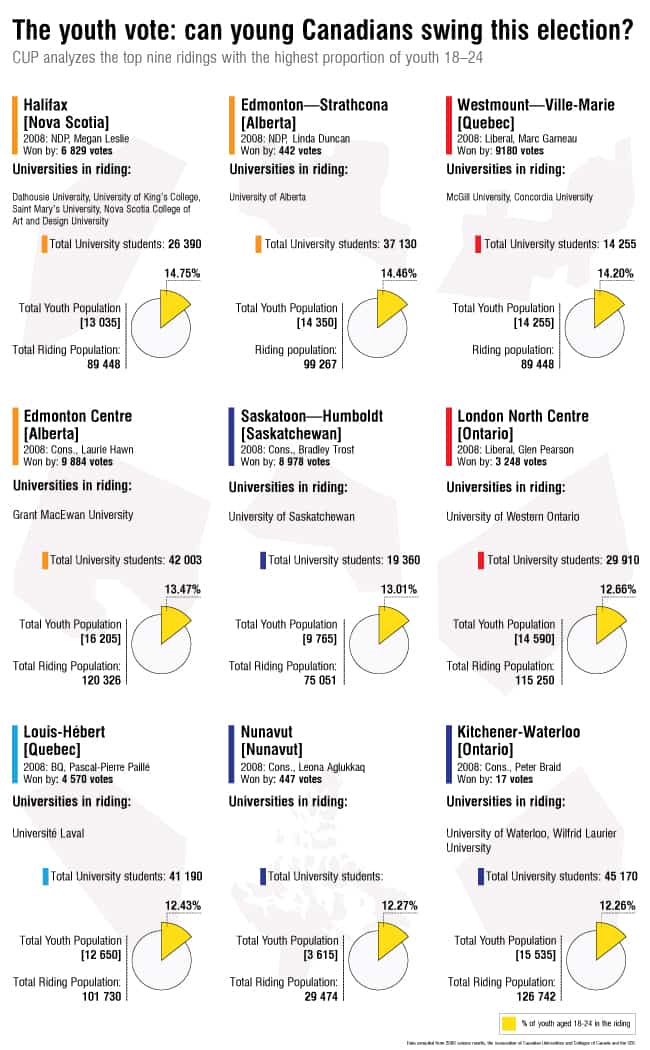EMMA GODMERE
CUP Ottawa Bureau Chief
 OTTAWA (CUP) — With less than two weeks to go before Canadians hit the polls on May 2, federal party leaders are certainly not the only ones who have kicked this election campaign into high gear.
OTTAWA (CUP) — With less than two weeks to go before Canadians hit the polls on May 2, federal party leaders are certainly not the only ones who have kicked this election campaign into high gear.
Take a glance through your Facebook news feed or your Twitter homepage and you’ll find videos, articles, messages and websites dedicated to motivating young Canadians to vote in this federal election.
In particular, some of the most visible youth-centric messaging has come out of student-organized “vote mobs” — large groups of young people mobilizing to encourage their peers to vote, who upload their final product onto YouTube. Thirty-five have either already taken place or will be occurring on campuses across the country in the next several days — and many were created in response to one of Canadian comedian Rick Mercer’s most recent rants about perennial low youth voter turnout.
“I really have to hand it to Rick Mercer in terms of working on getting the young people to vote in his [videos]. I think they’re great,” said Melissa Haussman, a political science professor at Carleton University. “I really hope it does continue to keep young voters’ imaginations up.”
Haussman explained that while it was too soon to say whether or not this recent swell of engagement will translate into higher numbers of youth at the ballot box, the “signs are looking good.”
Better yet, according to the demographics of some of the most hotly contested ridings this election, young Canadians could very well hold some power at the polls this year.
For example, out of the top nine federal ridings boasting the highest proportion of youth aged 18”“24, three experienced races so close in 2008 that fewer than 500 votes separated the winning candidate from the runner-up.
In the oft-talked about riding of Kitchener—Waterloo, where only 17 votes separated winning candidate Conservative Peter Braid from incumbent Liberal Andrew Telegdi, there are more than 15,500 residents between the ages of 18 and 24 — not to mention the 45,000 students who are enrolled in classes at the University of Waterloo and Wilfrid Laurier University, both campuses within the riding boundaries.
With such significant populations of youth and students present and potentially eligible to vote in these close-race ridings, is it possible that young Canadians could have a significant impact in this election?
“They could,” said Haussman, “if people specifically target them, mobilize them, keep going back to them, saying, ”˜Look, we really value your vote — are you planning to go to the polls on May 2?’
“In other words, one has to sort of walk hand-in-hand with whatever group you’re targeting and say, ”˜Your vote matters, this is important, the election depends upon you,’” she explained. “We’re seeing that at what we could say is the front end of the campaign, which has been the last two weeks, but it’s going to be really, really crucial to keep making those connections through the next couple of weeks.”
Haussman, who is originally from the U.S., remarked that young people have successfully made a difference in a political campaign before, back in 2008 when Barack Obama won the presidency.
“We know that the Obama campaign reaped the rewards of very, very heavy targeting and mobilization of young folks,” she said.
“Once they were excited, say, in the primaries, they kept working for him and then they turned out to vote for him. But the crucial thing here is you’ve got to get them interested and then you’ve got to keep after them to make sure they actually vote,” Haussman explained, warning that interest and engagement could be at risk of waning in the lead-up to May 2.
“In some ways, two weeks is like six months away in politics — people could forget all about it.”
Nevertheless, Haussman explained that the narrow riding wins Canadians saw back in 2008 can act as a strong impetus this time around, for all voters.
“People also have to realize not only that their vote matters, but how incredibly close these margins are — and so, in fact, their vote is more important than ever and their vote does make a huge difference,” she said.
See you how your vote can make a huge a difference by finding your riding in the map created by Canadian University Press.
—
Infographic: Jessie Willms/The Fulcrum